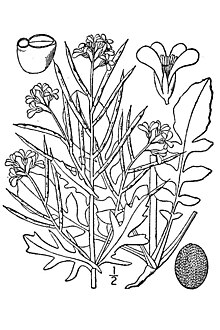Барбарея Верна
| Сухопутный кресс | |
|---|---|

| |
| Научная классификация | |
| Королевство: | Plantae |
| Клада : | Трахеофиты |
| Clade: | Angiosperms |
| Clade: | Eudicots |
| Clade: | Rosids |
| Order: | Brassicales |
| Family: | Brassicaceae |
| Genus: | Barbarea |
| Species: | B. verna
|
| Binomial name | |
| Barbarea verna | |
| Synonyms[1] | |
| |
Barbarea Verna - это биеннальная трава в семействе Brassicaceae . [ 2 ] Общие названия включают Land Cress , American Cress , Bank Cress , Crack Wood Cress , Cress Belle Isle , Бермудское кресс , капуста бедняка , ранний желтый [ 3 ] Ранняя зимняя обработка , цинги , Creasy Greens и Upland Cress . [ 4 ] Он родом из Южной Европы и Западной Азии и натурализован в других местах [ 5 ] Он выращивался как листовой овощ в Англии с 17 -го века. Поскольку это требует меньше воды, чем кресс -салат , его легче выращивать.
Описание
[ редактировать ]Ежегодный или раз в два года , зимний зеленый, травянистый растение в Brassicaceae . Семена обычно прорастают осенью, чтобы сформировать чрезмерную розетку. Следующей весной он увеличивает основной стебель примерно до 90 см, иногда до 130 см, что является бледно -зеленым, громким ( бороздкой ) и иногда разветвлена. Листья являются чередующимися и верны с помощью утомительной ушной линии у основания и от 4 до 11 пар субпозитных дол. Верхние листья имеют гораздо более узкие доли, чем те, которые находятся ниже вниз. Все растение почти полностью господа.
The flowers appear in early spring. The inflorescence is a terminal raceme, or lateral raceme arising from the leaf axils, with 6 to 25 flowers on short 3-8mm pedicels. There are four yellowy green sepals, 5mm long and four bright yellow petals each 8mm long. Six stamens and one style with a capitate stigma at the tip.
Uses
[edit]Land cress is considered a satisfactory substitute for watercress. It can be used in sandwiches, or salads, or cooked like spinach, or used in soup.[6]
Land cress can be grown easily in any garden. Like watercress, it loves water, but does not do well when partially submerged for long periods of time. This plant needs full sun or partial shade and moist or poorly drained soil.[7] It is a common green in Appalachian cuisine as one of few plants that can overwinter in the mountains.[4]
Other common names include dryland cress, cassabully, and American watercress. When cooked similarly to Southern collard greens the leaves may be called creasy greens. A variegated form is available.
See also
[edit]References
[edit]- ^ The Plant List: A Working List of All Plant Species, retrieved 8 May 2016
- ^ "Barbarea verna (Mill.) Asch". Plants of the World Online. The Trustees of the Royal Botanic Gardens, Kew. n.d. Retrieved September 27, 2020.
- ^ English Names for Korean Native Plants (PDF). Pocheon: Korea National Arboretum. 2015. p. 371. ISBN 978-89-97450-98-5. Archived from the original (PDF) on 25 May 2017. Retrieved 26 January 2017 – via Korea Forest Service.
- ^ Jump up to: a b "What's in Season: Creasy Greens". Garden & Gun. 2017-11-30. Retrieved 2020-08-22.
- ^ USDA GRIN Taxonomy, retrieved 8 May 2016
- ^ Nyerges, Christopher (2017). Foraging Washington: Finding, Identifying, and Preparing Edible Wild Foods. Guilford, CT: Falcon Guides. ISBN 978-1-4930-2534-3. OCLC 965922681.
- ^ "Barbarea verna". Royal Horticultural Society: Plants. Retrieved 20 October 2023.
External links
[edit] Media related to Barbarea verna at Wikimedia Commons
Media related to Barbarea verna at Wikimedia Commons- "Barbarea verna". Plants for a Future.
- Barbarea verna in the CalPhotos photo database, University of California, Berkeley

